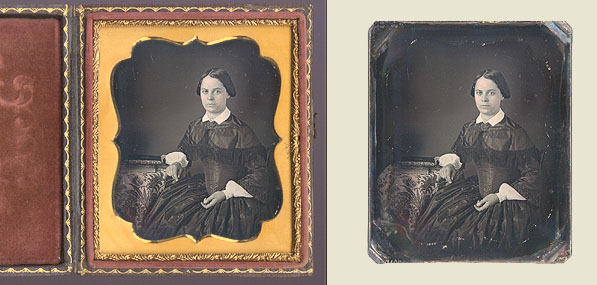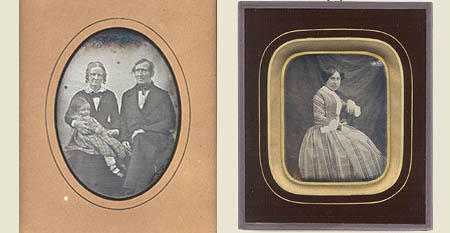19th Century Photographic Plate Sizes
|

At left: American sixth plate daguerreotype in typical housing -- case, brass "protector", cover glass, brass mat, and paper seal (not visible).
At right: The daguerreotype plate removed from housing to show plate size. The dimensions of the plate are approximately equal to those of the brassware in which it is housed.
(NB: Daguerreotypes are very easily damaged and should not be removed from their housings except by experienced professionals.) Note that plate sizes are approximate. Besides variation in the sizes of plates as they came from the manufacturer, finished plates were often trimmed on one or more edges by the photographer to allow for positioning under the mat. Any shifting of the plate under mat from exact center - to better center or otherwise improve the composition seen through the mat opening - would normally cause one or more plate edges stick out beyond the mat, and the photographer would have to trim off these projecting portions to allow the image package to fit in a standard-sized housing.
Plates were also trimmed down to oval or other shapes in order to fit them into odd-sized cases, often considerable reducing their size. In these cases the plate size is normally given as the size of the plate before trimming, assumed to be the smallest standard plate size from which the image could have been cut. To the opposite effect, small size plates were sometimes overmatted (placed under a larger-size mat with small opening or "window") in order to enhance the appearance of the finished package.
Other Plate Sizes:In Europe a larger size of half plate was often used, approximately 4.75 x 6.25 inches (12 x 16 cm), also called an "Oversize half plate" or "Larger-than half plate". There was also an intermediate size between quarter and half plate sometimes called a "Third plate". "Mammoth plate" was a size larger than whole plate. Tintypes were commonly produced in what is called "CDV-size", i.e. the size of a carte-de-visite, or roughly 2.5 x 4 inches (6 x 10 cm). Images in European-style Mounts:
European-style image housings, which were often intended for framing, employ paper mats, reverse-painted glass mounts, or passe-partout mounts with spacers. Images in these housings are often attributed incorrect, overly-large plate sizes due to a lack of understanding of how the mounts are constructed.

European image housings: Paper Mat (Left), Passe-Partout with gilt spacer (Right). The plate size of a daguerreotype, ambrotype, or similar image in a European-style housing is not equal to the size of its mount, and cannot be determined by examining the back of the mount or any openings or ridges found there. The most accurate way to determine the size of an image in a European mount, without opening it, is to measure the visible area of the plate. The plate's actual size will normally be the smallest standard size that would allow for such a visible area. European plates were often framed to show more of the image, to the point that the edges of the plate and plate hallmarks are sometimes visible even when housed in the mount.
Standard plate size dimensions (inches) are from Floyd and Marion Rinhart, The American Daguerreotype (1981).